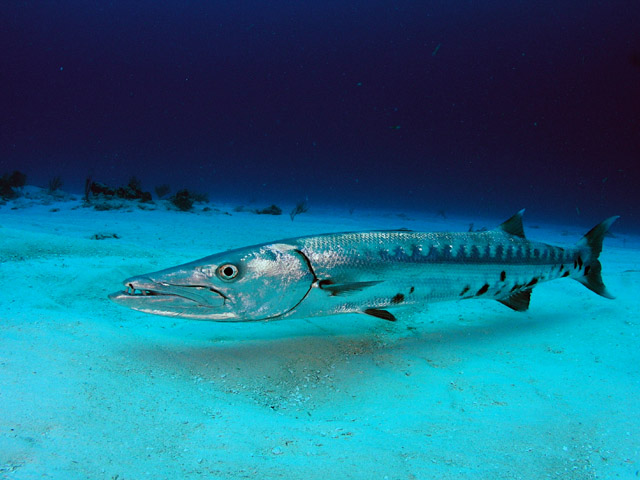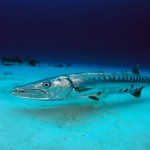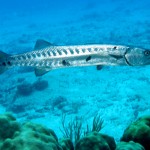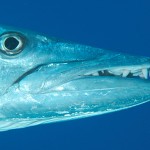Great Barracuda Facts
Scientific classification of Great Barracuda: Sphyraena Barracuda
Kingdom of Great Barracuda: Animalia
Phylum of Great Barracuda: Chordata
Class of Great Barracuda: Actinopterygii
Order of Great Barracuda: Perciformes
Family of Great Barracuda: Sphyraenidae
Genus of Great Barracuda: Sphyraena
Species of Great Barracuda: S.Barracuda
Great Barracuda
The great barracuda belong to the family of Sphyraenidae which in Latin terms means pike like. They have an elongated body with a gigantic mouth coupled with uneven teeth & strong jaws. They are also known as “Tiger of the Sea”. These species are also popular in the world of gaming.
Pictures of Great Barracuda
Some Interesting Facts about Great Barracuda
- These species consist of fang like teeth that gives it a dreadful look.
- They like to stay isolated but while mating, they form groups.
- These species are also called “Tigers of the Sea”.
- They can swim well by deflating and inflating the swim bladder.
- These species tend to stay still in the water for identifying the victim.
- They change the pattern and color of their body when they desire.
Distribution of Great Barracuda
These species are commonly found in the parts of Caribbean, Mediterranean, tropical waters and Western Atlantic. One could also spot them in the parts of Malaysia, Indonesia and Fiji and the Indian Ocean. Infact one can also find them along Western Atlantic including Massachusetts, Bermuda and somewhere near Brazil. In the North Western parts, it ranges from the Sierra Leone to the St Pauls Rocks. In the regions of Indo Pacific, they tend to cover the Eastern Africa to Hawaii and the Red Sea.
Characteristics of Great Barracuda
- Size of Great Barracuda: These species tend to grow 1.5 – 3 feet. The greatest size obtained yet is 6.6 ft.
- Weight of Great Barracuda: The weight of these species is 50 kg on an average.
- Mouth of Great Barracuda: These species have fang like jaws, a protruding head and a giant mouth. They have conical shaped uneven teeth. The gills are dotted with small scales.
- Shape of Great Barracuda: They have two dorsal shaped fins. The initial dorsal fins are located on top of the anal fin. It has 9 soft rays. The second is located directly above the pelvis.
- Color of Great Barracuda: These species are actually found in various colors including dark green, silver, blue and white at the side of the stomach.
Behavior of Great Barracuda
- These species are isolated by nature and tend to move very carefully as they do not possess eyelids.
- The younger ones form groups with thousands while moving and this also defends them from other fishes.
- These species are stalking predators. They tend to disguise near the areas of the sea grass. They even get engrossed in all kinds of glittering items as silver fish, which they commonly consume.
- They let out warnings even while asleep.
Food Habits of Great Barracuda
These species are carnivorous by nature. They always prefer to eat small fishes, grunts, bream, snupper, mullets. They are even cannibalistic because they also thrive on juvenile ones.
Habitat of Great Barracuda
One can spot these species in the sub tropical and tropical areas of the water. This may include shallow waters, coral heads, reefs, open seas, coastal lagoons and mangroves.
Predators of Great Barracuda
These species are the first on the food chain of the fishes. The younger ones often fall in the trap of the bigger fishes. The main predators of the bigger species are the dolphins, giant tunas, goliath grouper and sharks.
Adaptations of Great Barracuda
During foraging, they tend to move their sleek body through the reefs. These species have dorsal fins that make it a swift swimmer. Their powerful jaws and conical shaped teeth also act as great defensive tools. They also have the skill to inflate & deflate their bodies. In fact this also helps them to rise up or move down in the sea.
Nutritional Facts of Great Barracuda
The fish is largely consumed by human beings. The nutritional details of one ounce of fish (boneless) have been presented below:
- Fat: 2.77g
- Calories: 49
- Carbohydrate: 0.09g
- Protein: 5.39g
Importance of Great Barracuda to Human Beings
These species are recognized as game fishes instead of the commercial variety. The bigger fishes should be avoided in human consumption as they generally accumulate the ciguatera toxin responsible for ciguatera poisoning within their bodies. People affected by the same generally suffer from gastrointestinal and heart troubles.
The fish has been mistakenly taken by many as a threat to human beings primarily because of its threatening appearance. One can avoid attacks by these fishes by simply not carrying any knife or other such shiny article that can be misunderstood as a fish by the great barracuda.
Reproduction of Great Barracuda
These species mate during the months of April to September. Male get mature sexually at the age of 3 years while the female counterparts gets matured at the age of 4 years.
They prefer to breed in the shallow portions of the water where it is warm. Post mating, the females reproduce about 5000- 30,000 eggs. The female counterparts lay eggs and allow it to drift in water. The offspring usually take shelter in shallow portions of the water until they get matured to move out to the open sea.
Life Cycle of Great Barracuda
These species tend to settle down on the areas with a lot of marine vegetation is available and prefer locations that allow fortification and food. Initially they start to stay in the shallow estuaries. Once they attain maturity they move into deeper seas.
Life Span of Great Barracuda
These species live for about 14 years.
Conservation Status of Great Barracuda
The populations of these species are very stable. They are not in the category of threatened. Initially they were consumed for meat. However now they are not taken because of health problems like headaches, muscle pain, blood pressure etc.




